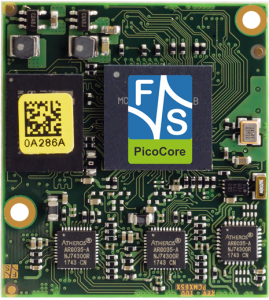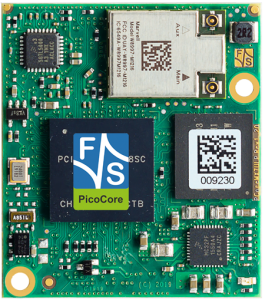PicoCore™80
| PicoCore™MX7ULP | PicoCore™MX6UL | PicoCore™MX6SX | ||
| Status | Production | Production | Production | |
| CPU | - | - | - | - |
| Typ | NXP i.MX 7ULP | NXP i.MX 6ULL | NXP i.MX 6SoloX | |
| Kern | ARM Cortex-A7 + Cortex-M4 | ARM Cortex-A7 | ARM Cortex-A9 Cortex-M4 |
|
| Anzahl Kerne | 1 + M4 | 1 | 1x A9 + M4 | |
| Frequenz | max. 720MHz | max. 900MHz | max. 800MHz + 200MHz | |
| L2-Cache | 256KB | 128KB | 256KB | |
| GPU | 2D, 3D | - | 2D, 3D | |
| Security | - | - | - | - |
| Secure Element | - | SE050 | - | |
| Betriebssystem | - | - | - | - |
| Linux | Yocto, Buildroot (uboot installed) |
Buildroot/ Yocto (uboot installed) |
Buildroot Yocto (uboot installed) |
|
| Windows | - | auf Anfrage | auf Anfrage | |
| Echtzeit | FreeRTOS | - | FreeRTOS | |
| Speicher | - | - | - | - |
| Flash | max. 64MB QSPI max. 32GB eMMC |
max. 512MB SLC oder max. 32GB eMMC |
max. 512MB SLC NAND | |
| eMMC | - | - | max. 64GB | |
| RAM | max. 1GB LPDDR3 | max. 1GB DDR3L | max. 1GB DDR3L | |
| Schnittstellen | - | - | - | - |
| SD-Karte | 1x SDIO | 1x extern | 1x SDIO | |
| Ethernet | - | max. 2x | max. 2x 100/1000Mb | |
| WLAN | 802.11 ac/a/b/g/n | - | - | |
| BT | 5.0 LE | - | - | |
| USB Host | 1x HSIC | 1x | 1x | |
| USB Device | 1x OTG | 1x | 1x OTG 2.0 | |
| CAN | - | max. 2x | max. 2x | |
| UART | 5x | max. 6x | max. 5x | |
| I2C | 3x | max. 4x | max. 3x | |
| SPI | 1x | max. 4x | max. 2x | |
| Audio | Line In/ Out/ Mic/ Headphone/ I2S | Line In/ Out/ Mic/ Headphone/ I2S | Line In/ Out/ Mic/ Headphone/I2S | |
| Touch Panel | via I2C or USB | via I2C or USB | via I2C or USB | |
| RTC | externer IC | external IC | external IC | |
| sonstige Schnittstellen | - | max. 8x PWM, SPDIF, ESAI, 3x SAI, SSI ADR/ DATA Bus |
max. 8x PWM, SPDIF, ESAI, SAI, SSI ADR/ DATA Bus |
|
| Display | - | - | - | - |
| RGB | - | 24bit | 16/ 24bit | |
| MIPI-DSI | 1x 2 Lanes | - | - | |
| Allgemein | - | - | - | - |
| V_IN | +5VDC/ ±5% / 4.2V Battery | +3.8V bis 5.5VDC | +3.8V bis 5.5VDC | |
| T_AMB | 0°C - +70°C -20°C - +85°C |
0°C - +70°C -20°C - +85°C |
0°C - +70°C -20°C - +85°C |
|
| Größe | 35x40mm | 35x40mm | 35x40mm | |
| Verfügbarkeit | 2029 | 2035+ | 2035+ | |
| PicoCore™MX7ULP | PicoCore™MX6UL | PicoCore™MX6SX |
Der kompakte Computer on Module Formfaktor PicoCore™ zeichnet sich durch seine geringe Größe von nur 35 x 40 mm und einem sehr geringen Board-to-Board Abstand ab 1,5mm aus.
Die PicoCore™ embedded Module sind robust, haben eine geringe Verlustleistung und eine hohe Performance. Sie sind bestens geeignet für tragbare Geräte in der Medizin- und Industrietechnik, Multimediaanwendungen oder auch für sichere Cloudverbindungen.
Auf dem ARM-basierten PicoCore™ Formfaktor steht ein Cortex®-A53 Kern und ein Cortex®-M4/M7 Kern zur Verfügung. Eine integrierte 3D und 2D Hardwarebeschleunigung ist im Prozessor enthalten.
Als Speicher werden SLC NAND Flash und alternativ auch eMMC angeboten. Die zwei 80-poligen Steckverbinder ermöglichen eine Vielzahl an Schnittstellen wie 1x SD-Card Slot, 1-2 Gigabit Ethernet, 2x USB, CAN, max. 4x I2C, 2x SPI, max. 6x UART, Audio (Line In/ Out/ Mic/ Headphone oder I2S), GPIO und PWM für Kameraanbindung.
Zum Anschluss eines Touchpanels wird I2C verwendet. Optional steht bei einigen Versionen auch ein WLAN/ BT Modul zur Verfügung.
Wir unterstützen Sie optimal bei Ihrer Softwareentwicklung. Für jedes PicoCore™ Modul stehen umfangreiche, sofort lauffähige Development Kits mit Display zur Verfügung.
Die F&S Ingenieure leisten Support via Forum, Telefon und E-Mail. Des Weiteren bieten wir umfangreiche Leistungen in den Bereichen Over-The-Air Update, Secure Boot, Asymmetrisches Multiprocessing und vielem mehr.






